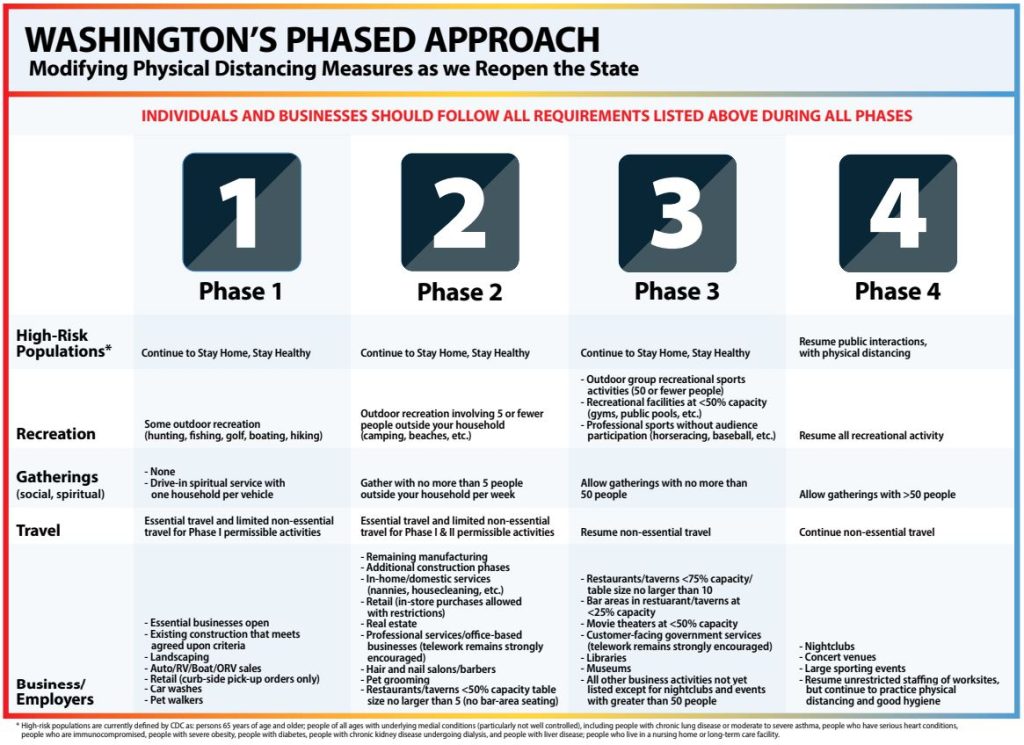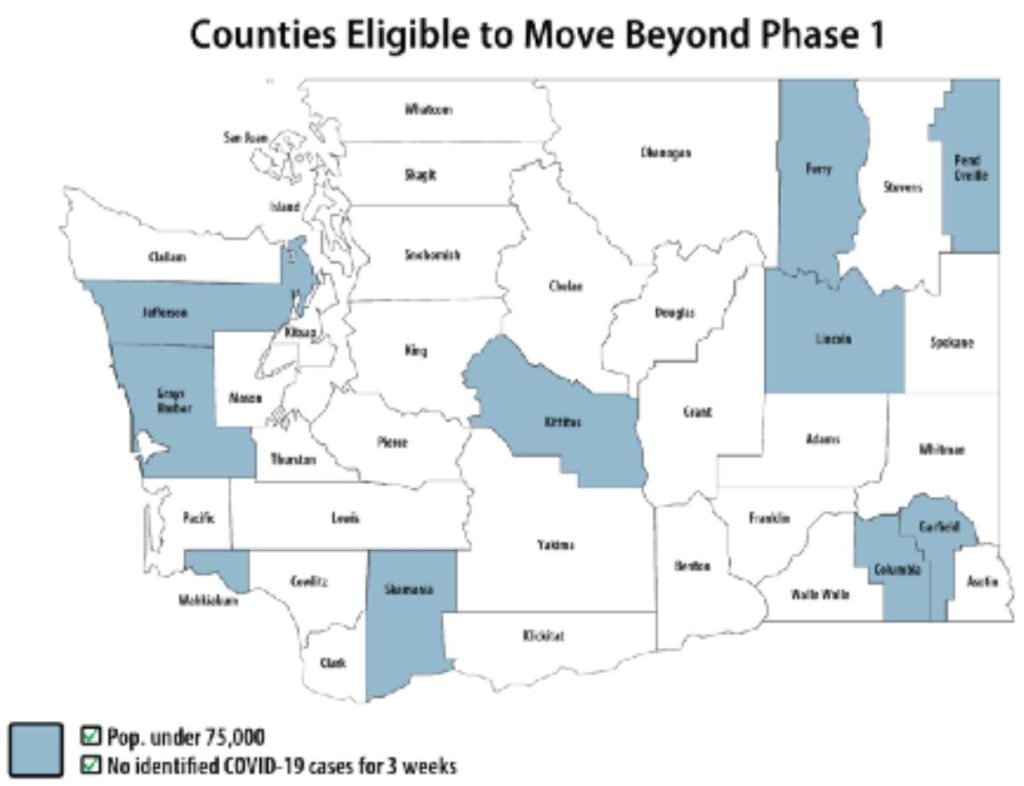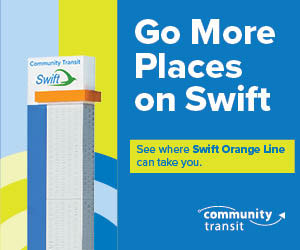Safe Start is a data-driven plan that includes regional variances based on population and low COVID-19 counts.
By Governor Jay Inslee | Press Release
Some businesses could re-open as early as this week under the new COVID-19 order signed by Gov. Jay Inslee today. The state’s “Safe Start” plan is a phased approach to re-opening Washington’s economy.
Under the plan, smaller counties can apply for a variance from the order which would allow them to open even more businesses than allowed statewide.
Safe Start sets a careful approach to emerging from the pandemic. It allows for modifications of business closures and physical distancing measures while minimizing the health impacts of COVID-19.
“This phased approach to re-opening our economy will allow us to move forward with a careful and thoughtful balance of our state’s health and economic needs,” Inslee said. “However, if infection rates and hospitalizations for COVID-related issues go up, I would not hesitate to scale these efforts back down to protect public health and save lives.
“I fully recognize the impact this is having on families, workers and businesses, but we have not yet won the fight against this virus,” Inslee continued. “We continue to see infection rates, hospitalizations and deaths across the state from COVID-19.”
While Stay Home, Stay Healthy is being extended to the end of May, the governor announced his Safe Start plan which amends some components of the original order and allow for a start to re-open the state.
Through the Washington “Safe Start” plan, more businesses and activities would re-open in phases with adequate social distancing measures and health standards in place. Each phase will be at least three weeks — data and metrics will determine when the state can move from one phase to another.
Read the full Safe Start policy plan here.

Safe Start — Phase 1
Phase 1 timing:
Washington state is currently in Phase 1, with construction and other essential activities underway. The additions such as outdoor activities and additional sales and retail activities begin Tuesday, May 5. When the state moves to Phase 2, all components of Phase 1 will continue.
Phase 1 includes:
Phase 1 builds upon recent decisions made around re-opening some activities, including construction activity (allowed as of April 29) and outdoor activities such as fishing, hunting, playing golf and some park access, which Inslee announced last week.
Phase 1 also adds (as of May 5):
- Drive-in spiritual services with one household per vehicle
- Auto/RV/Boat/ORV sales
- Retail open for curb-side pick-up orders only
- Car washes
- Landscaping
- Some pet services (not including grooming)
- Essential travel and limited non-essential travel to engage in Phase 1 activities is permitted.
Safe Start Phase 2:
When COVID-19 disease burden is low and decreasing and the four capabilities (health care system readiness; testing capacity and availability; case and contact investigations; and ability to protect high-risk populations) are met, the governor will issue an order for the state to move into Phase 2.
As noted above, each phase will be at least three weeks, data and metrics will determine when the state can move from one phase to another.
Phase 2 includes:
All components of Phase 1 will carry into the start of Phase 2, which will include outdoor activities in small groups with people from outside one’s household, as well as limited non-essential travel within proximity of one’s home.
Additional modifications to restrictions in Phase 2 affecting business will include:
- Remaining manufacturing and construction phases
- Restaurants/taverns less than 50% capacity/table size no larger than 5 people and no bar area seating
- Hair and nail salons
- Retail (in-store purchases allowed with restrictions)
- Real estate
- Professional services/office-based businesses (telework remains strongly encouraged)
- In-home/domestic services (i.e., nannies, housecleaning)
- Pet grooming
- Essential travel and limited non-essential travel to engage in Phase 1 and Phase 2 activities is permitted.
Safe Start Phase 3
If COVID-19 disease burden stays low and the four capabilities (health care system readiness; testing capacity and availability; case; and contact investigations and ability to protect high-risk populations) are met, the governor will issue an order for the state to move into Phase 3.
Each phase will be at least three weeks, data and metrics will determine when the state can move from one phase to another.
Phase 3 includes
All components of phases 1 and 2 will carry into the start of Phase 3, which will include resuming non-essential travel and allowing gatherings of no more than 50 people.
Phase 3 also includes resuming some public activity, such as:
- Outdoor group recreational sports activities (50 or fewer people)
- Recreational facilities at less than 50% capacity (gyms, public pools, etc.)
- Professional sports (horse racing, baseball, etc.) without audience participation
- Restaurants and taverns at less than 75% capacity with table size no larger than 10
- Bar areas in restaurants and taverns at less than 25% capacity
- Indoor gyms at less than 50% capacity; theaters at less than 50% capacity
- Customer facing government services (telework remains strongly encouraged where possible)
- Libraries
- Museums
- All other business activities not yet listed except for nightclubs and events with no more than 50 people.
Safe Start Phase 4
Phase 4 includes:
If COVID-19 disease burden stays low and the four capabilities (healthcare system readiness; testing capacity and availability; case and contact investigations; and ability to protect high-risk populations) are met, the governor will issue an order for the state to move into Phase 4.
All components of phases 1, 2 and 3 will carry into the start of Phase 4 which would be a full return to public interactions (with appropriate physical distancing).
Ability for smaller counties with fewer cases to open sooner
Inslee also announced on Friday, through the Safe Start approach, counties with a population of less than 75,000 that have not had a new case of COVID-19 in the past three weeks can apply to the state Department of Health with a plan to reopen more sectors of public life there.
“I am also mindful of regional differences and impacts across the state with regard to the spread of COVID-19 and our response. Not every part of our state is experiencing this pandemic in the same way. Therefore, some counties with lower numbers of cases and deaths, as well appropriate levels of PPE and hospital capacity, may explore plans for reopening businesses sooner,” Inslee said.
Counties that meet the criteria will have the opportunity to apply for a variance to move to Phase 2 of “Safe Start” before other parts of the state. To apply for a variance, the local jurisdiction must follow the below process and submit the following materials to the Department of Health. County variance applications will be approved or denied by the secretary of the Department of Health.
Currently, the following counties meet established criteria: Columbia; Garfield; Jefferson; Lincoln; Pend Oreille; Skamania; Wahkiakum; Kittitas; Ferry; and Grays Harbor.

Counties that meet the criteria and wish to submit a variance application must:
- Submit a signed recommendation from the local public health officer to the local board of health with one of the following recommendations: not to request a variance and stay in Phase 1; to request a variance to include all of the Phase 2 modifications above; or request a subset of Phase 2 modifications.
- The local board of health, if they choose to move forward with a variance request, must vote on such a request.
- The local hospital(s) must submit a letter certifying that they have adequate bed capacity to serve their community and adequate PPE supplies to keep their workers safe.
- The county commission/council must request to move to Phase 2 (or a subset of Phase 2) of the “Safe Start” plan.
“Six months ago, we didn’t know anything about COVID-19. As of last week, as many people have died from it in the U.S. as all the U.S. soldiers in the eight years of major combat in Vietnam,” Inslee said Friday. “We are not wrestling with whether to lean toward the economy or the public health. They are one. As economist Justin Wolfers put it Thursday, ‘There’s no economic health without public health.’”
For more information:
- Safe Start policy plan
- Gov. Jay Inslee’s proclamation extending “Stay Home, Stay Healthy” until May 31.








